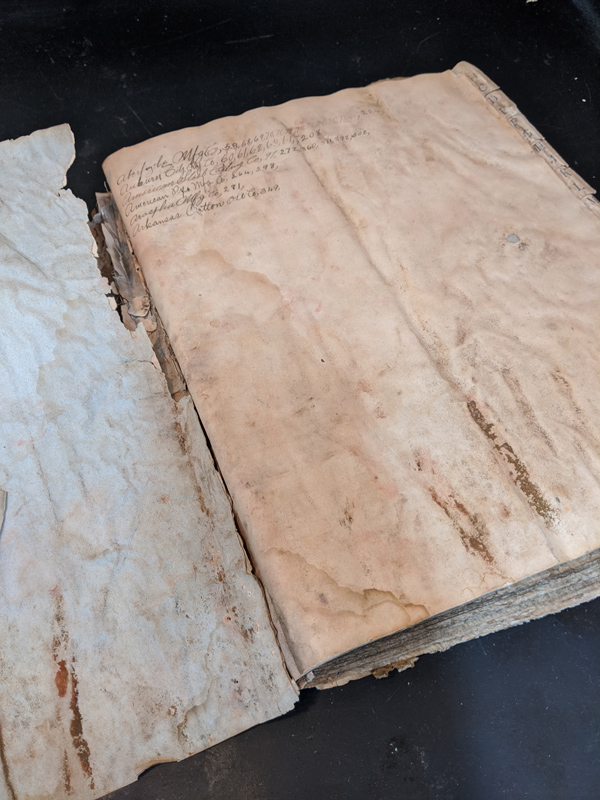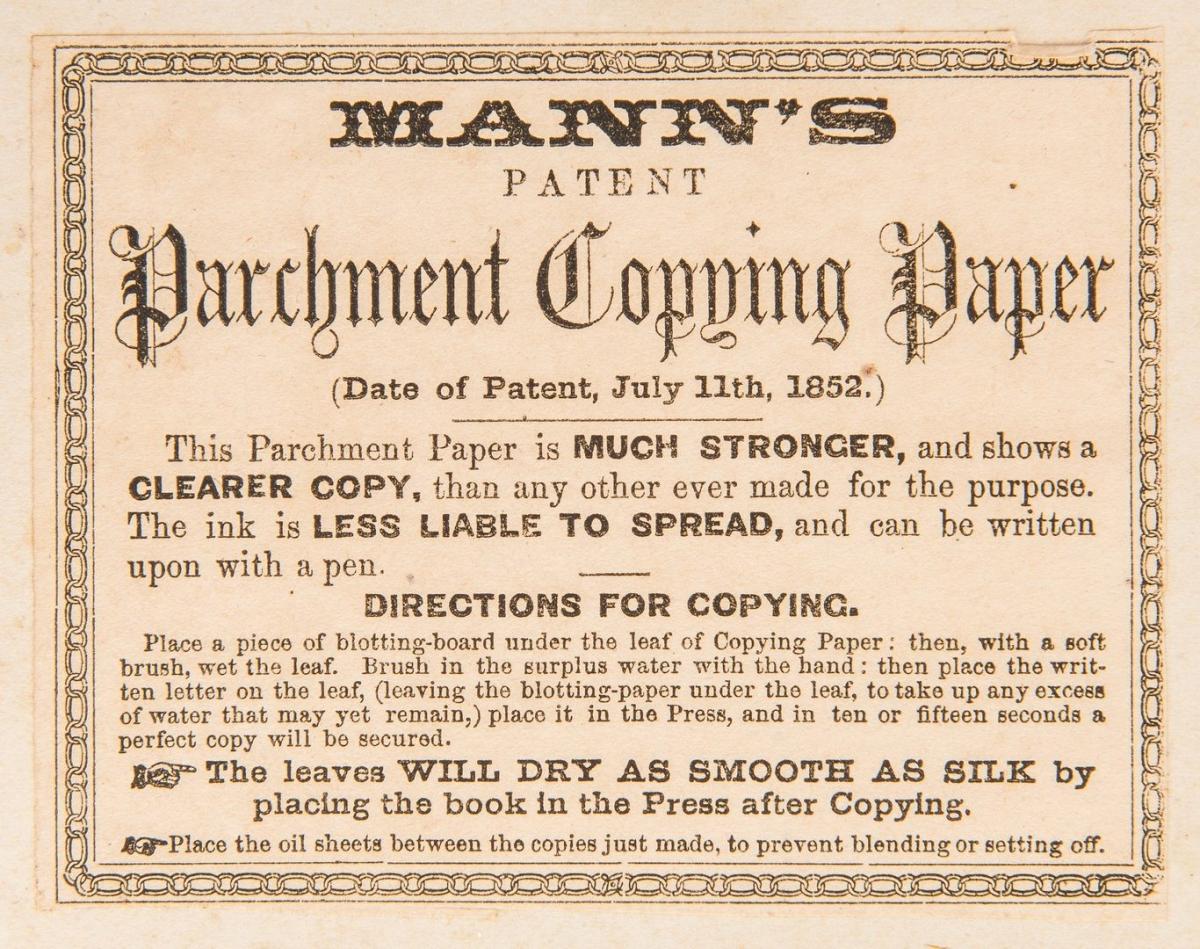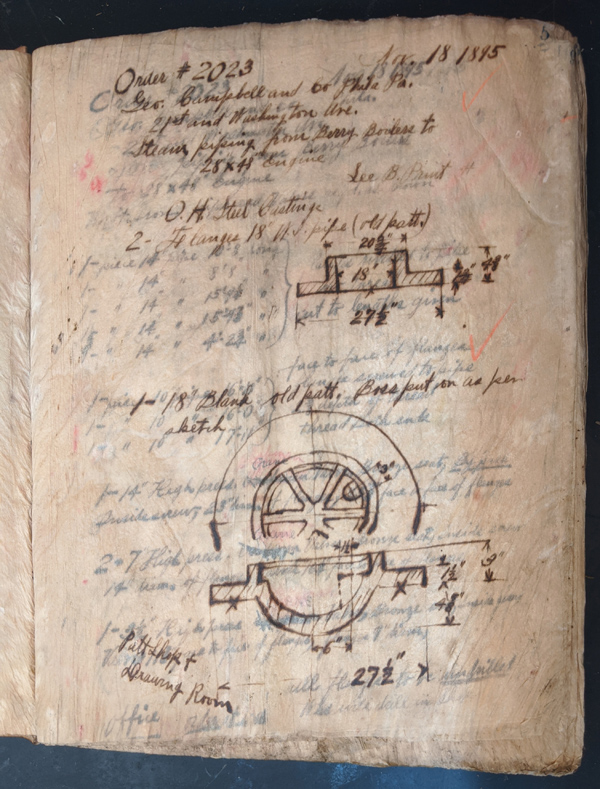Conservation begins with an examination of the item in question. Contemplating the materials and history of documents and artifacts help us make the right decisions for planning the course of treatment. That can be difficult to do in an emergency. A group of five 19th century copy books of business records did not get a full evaluation when they became wet. The books were already in bad shape prior to getting wet. They were heavily coated with powdery mold residues, inside and out, damage that happened long before arrival at Hagley. The black cloth-covered boards were moldy, wet, and seemed plain and insignificant, without decoration or writing. The decision was made to remove the covers to aid in drying the rest of the pages. They were discarded, but not before photographs were taken to document these original pieces.

In writing the condition report in preparation for treatment, I reviewed the photographs. One of the inside cover showed the label where the copy books were sourced. The pages are Mann’s Parchment Copying Paper. According to the label it was “Much stronger and shows a clearer copy then any other ever made for the purpose. The ink is less liable to spread and the paper can be written upon with a pen.”

Based on the manufacturer label, I decided to delve deeper into the materials, manufacture, and use of these objects. William Mann of Philadelphia patented his parchment copying paper formulation in 1852. For next 20 years the Mann company had copybook manufacturing cornered in the U.S. They produced their own paper at a mill in Lambertville, New Jersey. Assembly, page numbering, and binding of the books were completed in Philadelphia where they also had a store.
Before photo copiers, typewriters, or carbon copies, using a letter copying press was one ingenious method for duplicating business and personal records. To make a facsimile, a document was placed in contact with a dampened sheet of paper before the ink had dried. Together they were dried under pressure in a screw press, and some of the ink from the original was absorbed onto the damp sheet. When copying to a bound book, only the pages to be used for that day’s letters were moistened. To prevent transfer of ink and moisture between pages, hydrophobic oiled paper was inserted. The blank copy book pages were moistened either by damp blotters or application of water by brush. Copying papers were thin, smooth, and translucent to enable reading of the text from the side opposite of the ink transfer.
The pages of the copy books I examined are light tan, thin, translucent paper. Because of the translucency, the writing on the underlying sheets is visible, making it difficult to read until plain paper is placed between the pages. The brown ink looks like typical iron gall ink. Some of the ink has moved laterally and the writing has feathered edges. A few areas have iron gall ink corrosion, where it has damaged the paper, leaving small holes. Even though these volumes have experienced water damage, this has not resulted in pervasive iron gall ink corrosion as might be expected. All the pages have a fine crepey, wrinkled texture. This gives the full stack of pages forming the textblock a cushiony character.

At first glance, the pages appeared to be in terrible condition. It seemed that every sheet had some amount of mold residues, soot, and silt. They were stuck together, but I found carefully sliding a spatula of smooth Teflon between the pages made it possible to separate them. They weren’t exactly adhered together, rather they had shrunken, and the wrinkles were causing the attachment. After paging through the 5 volumes my impression of their condition changed somewhat. (Don’t get me wrong, these things will require a lot of work to bring them to useable shape.) Yet, it is surprising at how strong and flexible the paper remains. While there is a lot of mold, there does not seem to be much mold staining or mold spores embedded in the paper – at least not the amount expected based on the water exposures.
Mann’s parchment paper patent called for the combination of Manila hemp (abaca) fiber with cotton. Fairchild's Dictionary of Textiles, explains that abaca fibers come from the leaf stem of the plant, which is a member of the banana family. The individual fibers from the plant may be longer than 10 feet.
This fiber is often used for marine rope as it floats and resists deterioration by saltwater. Abaca fiber could be cream or brown, and is probably responsible for the color of this paper. The presence of abaca provides wet strength. Mann’s patent claims that other copy papers were weak when wetted during the ink transfer process.
Some copybook papers were treated with glycerin or deliquescent salts to increase their moisture content for the ink transfer process. Copying inks were sometimes formulated with sugar to create the right consistency and moisture content. Colorants like indigo and logwood dyes were often added to the iron gall ink base. Chemicals, called mordants, could be added to the paper to help bind the inks. No additives are mentioned in Mann’s patent for parchment copy paper, however.
As I continue with the study of these copybooks, I will sample the paper fibers to confirm which plants they came from. The pages and inks will be viewed under ultraviolet light, which can reveal ink migration, and indicator papers will be used to confirm the presence of iron gall ink deterioration.
SOURCES
Office Appliances: The Magazine of Office Equipment, Volume 37, February 1923 pg 78
Rhodes, Barbara and Streeter, William. Before Photocopying: The Art & History of Mechanical Copying, 1780-1938 : a Book in Two Parts. Oak Knoll Press. 1999
Laura Wahl is the Library Conservator at Hagley Museum and Library.
